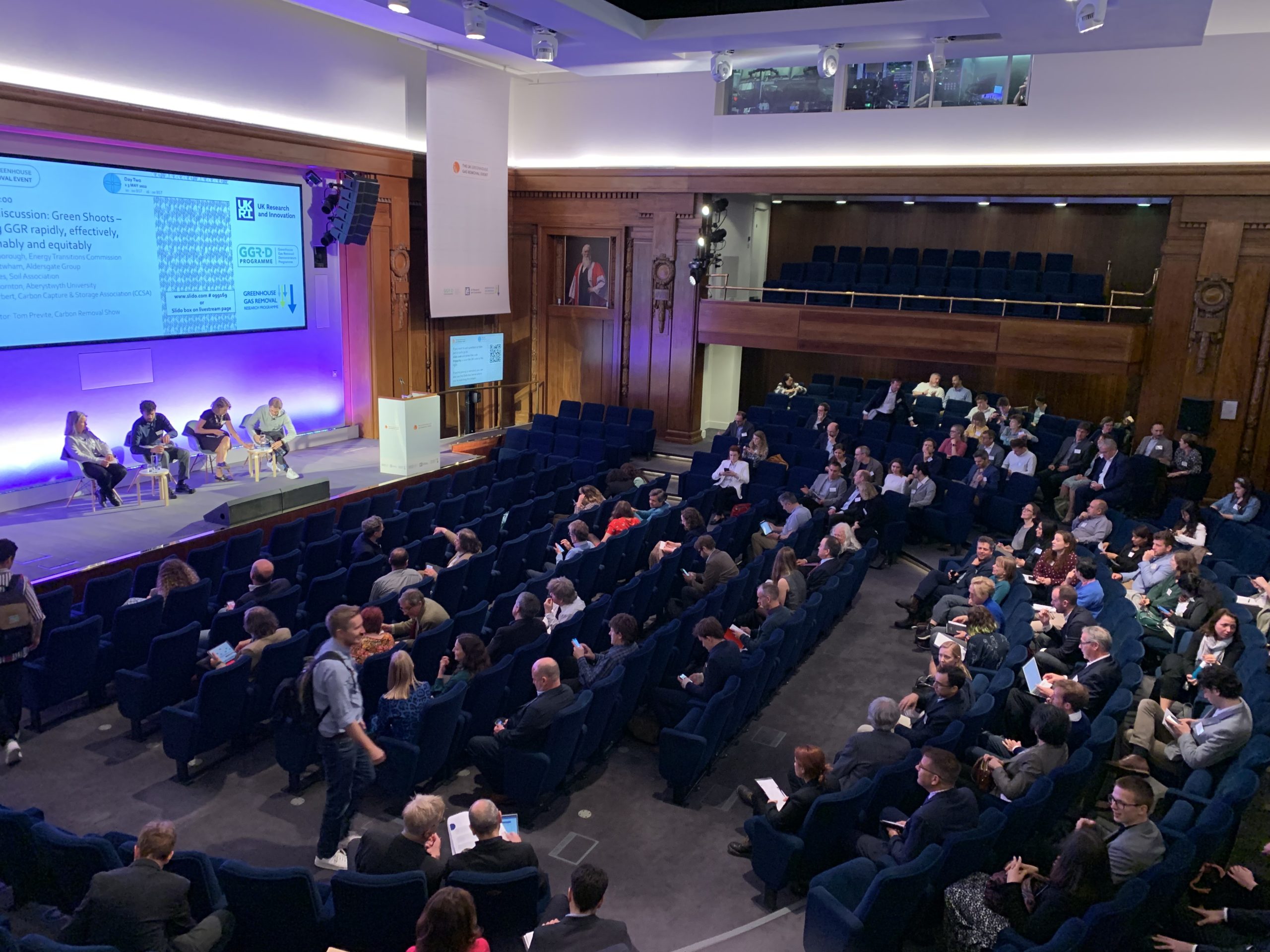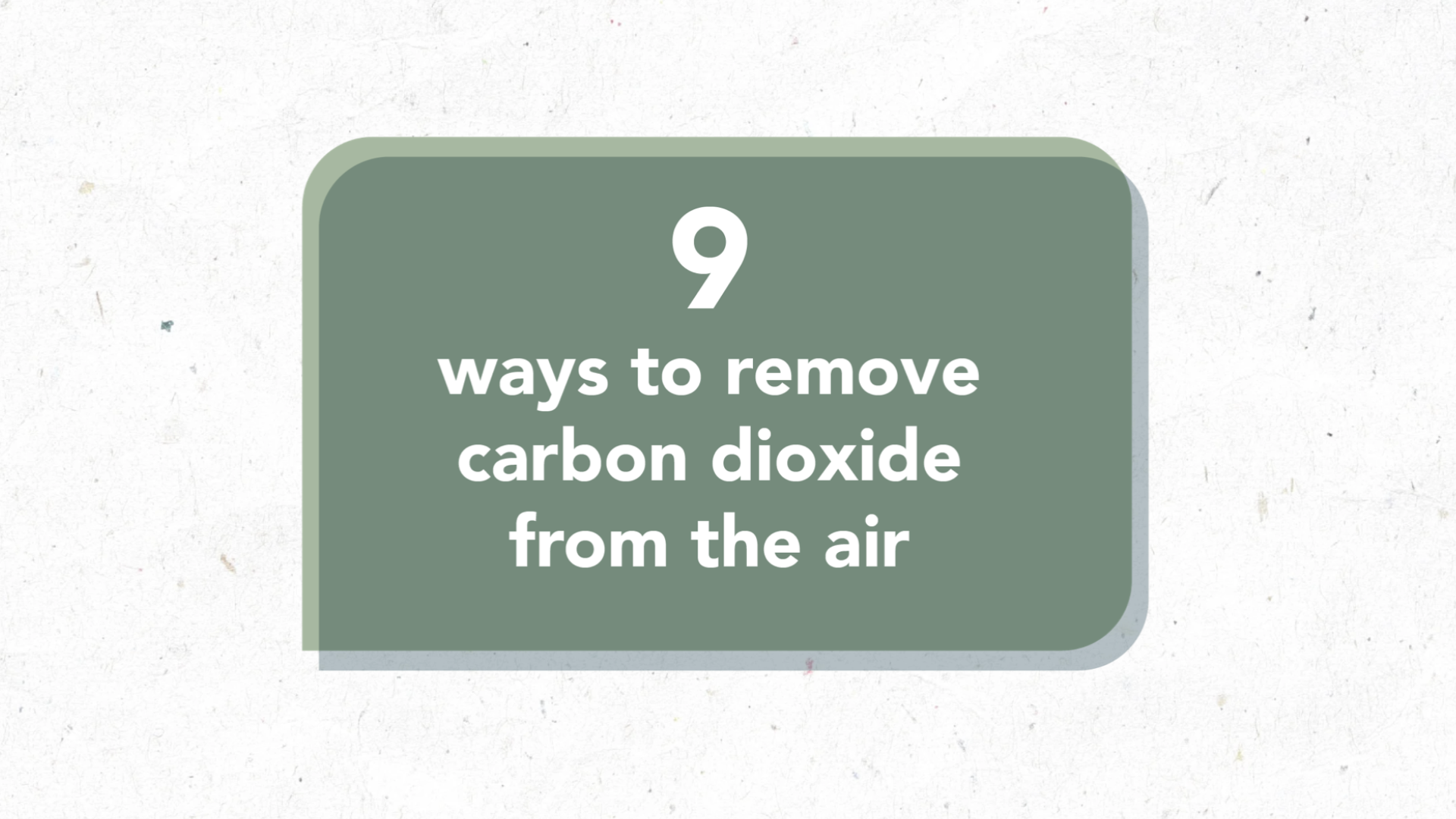By George Hope
Two UK Greenhouse Gas Removal research programmes convened a first-of-its-kind event in London to bring together the burgeoning Greenhouse Gas Removal (GGR) community earlier this month. Researchers, policymakers and industry representatives met to present and discuss various approaches to removing greenhouse gases from the atmosphere, and how they could contribute to the UK reaching net zero emissions by 2050.
The two-day flagship event showcased the latest GGR research and innovation, highlighting its role in effective, sustainable and equitable climate action. Day one was coordinated by the Greenhouse Gas Removal Research Programme (GGR-A), which is wrapping up its research after four years, and day two by the new Greenhouse Gas Removal Demonstrators Programme (GGR-D), which is coordinated by CO2RE.
Below are just a few of the key takeaways. You can also watch the full collection of event videos.
1. We need Greenhouse Gas Removal and drastic emissions reductions, not one or the other
It was at the time of the Paris Agreement, said Professor Gideon Henderson, Chief Scientific Advisor at the Department for Environment, Food and Rural Affairs, that it was “formally part of the discussion that we were going to have to do significant removal of carbon from the atmosphere as well as cut our emissions, if we were going to reach the net zero target.”
A key point here, which was repeated in many of the panel discussions and keynote speeches, is that Greenhouse Gas Removal is necessary, but not instead of huge emissions reductions.
“GGR is hard and expensive,” Prof Henderson continued, “and we cannot afford to see it as a surrogate to compensate for continued emissions in sectors that can be decarbonised. It’s not an excuse not to decarbonise – we must drive down emissions anyway.”
Whilst it has been known for nearly ten years that removals may be necessary to constrain warming to 1.5 to 2 degrees, the latest Working Group Report by the UN’s Intergovernmental Panel on Climate Change (IPCC) has unambiguously stated that Carbon Dioxide Removal (CDR) is “unavoidable if net zero CO2 or GHG emissions are to be achieved”. [1]
This means that the conversation has shifted from whether we need removals, to which approaches to take forward, how to incentivise them and how to govern them.
2. Scientists are already trialling a range of techniques to remove greenhouse gases from the atmosphere
Both days saw presentations from five demonstrator projects, all trialling innovative GGR and part of the GGR-D Programme alongside CO2RE.
The techniques include:
- understanding the extent and scope of deploying biochar
- exploring amending soils with crushed silicate rocks from waste quarry fines (enhanced rock weathering)
- restoring and enhancing peatlands
- investigating the potential for perennial crops like willow and miscanthus to support BECCS
- addressing knowledge gaps in creating and managing woodlands
This followed on from day one’s presentations of the key findings and high-level outcomes of the outgoing GGR-A Programme. Running from 2017 to 2021, it included 11 projects exploring methods such as afforestation, BECCS and enhanced weathering, plus cross-cutting questions around effects on the land sector and whether GGRs might deter mitigation efforts.
Dr Steve Smith announced that CO2RE will be funding four early-stage GGR ideas that might prove to be promising, including on biochar from bio-organic wastes, methane removal, evolved aquatic microbial communities, and enzyme-enhanced carbon capture and storage in basalt rocks. Find out more about CO2RE’s funding opportunities.
3. High quality monitoring, reporting and verification (MRV) is essential for successful deployment of GGR
A theme that came up across multiple panels and presentations was the need for strong and robust monitoring, reporting and verification (MRV), largely about defining and standardising how you measure Greenhouse Gas Removal and the permanence of the achieved sequestration.
“We’ve got to be very careful that we really are having the impact that we think we’re having and that we’re also not having secondary impacts on the environment,” said Prof Mark Taylor, Deputy Director – Energy Innovation, Department for Business, Energy & Industry.
He noted that a key part of the GGR programmes is understanding the general impacts on the environment as well as proving technologies can capture carbon effectively.
4. We can’t just ‘do GGR’, we have to do it effectively, sustainably and equitably
One panel discussed how GGR can be scaled effectively, sustainably and equitably, topics that were also present throughout the two days.
The panel highlighted issues such as:
- Ensuring GGR doesn’t slow down decarbonisation activities
- The need for a portfolio of GGR approaches
- The regulation needed to scale GGRs at pace
- Who pays for removals, and how
- How we consider equity in land-use change
Relatedly, Dr Steve Smith announced at the event that CO2RE is developing a multi-disciplinary Evaluation Framework, reflecting key aspects of GGR scalability in the UK, such as permanence, costs, social-ecological impacts, social readiness, and other factors. We are seeking stakeholder input and feedback as we build the tool – find out more on its dedicated page.
5. Investment in GGR is growing, and it’s vital
Professor Cameron Hepburn, Director of the Smith School of Enterprise and the Environment and CO2RE’s principal investigator, opened day two by noting the significant growth we need in GGR:
“[The GGR industry] is very small now compared to where it needs to be, and the scaling up process is going to be probably pretty bumpy, but it’s going to be exciting, and huge in a capital market and investment sense.”
Professor Hepburn then went on to speak about getting this opportunity right not just for climate but for a range of issues: “We need to make sure it’s done equitably and sustainably, that we’re not just sorting climate but we’re managing to deal with lots of other environmental and social problems at the same time.”
Later in the day, Pilita Clark of the Financial Times chaired a panel discussion on ‘Who is investing in GGR, and why?’ with experts from the Forestry Commission, Counteract, Bank of America and Microsoft. Clark began the conversation by saying that the idea of investing in carbon removal is “a source of growing interest to our readers”.
The discussion covered the opportunities for and barriers to solutions being deployed at scale, the role of corporates in helping to scale nascent GGR methods, and how we can move towards strong and robust monitoring, reporting and verification (MRV), thereby facilitating better transparency and visibility of risk.
Watch the full panel discussion on investing in GGR:
6. It’s an exciting time to be part of the emergent and vibrant GGR ecosystem
The event was a showcase of the growing and vibrant UK GGR ecosystem, with scientists, social scientists, economists, policymakers, investors, start-ups and journalists attending. The two-day conference was one of the largest of its kind to date to bring together the Greenhouse Gas Removal community and those interested in finding out more. However, we do recognise that the GGR community is insufficiently diverse and are taking steps to improve it – find out more on our ‘How we work’ page.
If you would like to find out more about the event, you can:
- Read Carbon Brief’s write-up: ‘Greenhouse Gas Removal: How could it help the UK reach net zero by 2050?’
- Watch the full collection of event videos
If you would like to engage further with CO2RE, sign up to our newsletter, follow us on Twitter or get in touch via email.
[1] Note: IPCC do not include the removal of other GHG in their scenarios.





